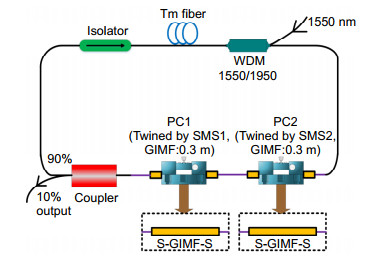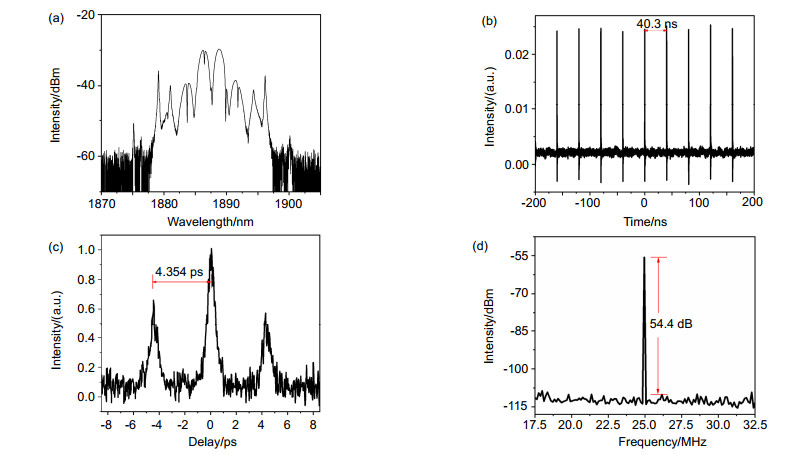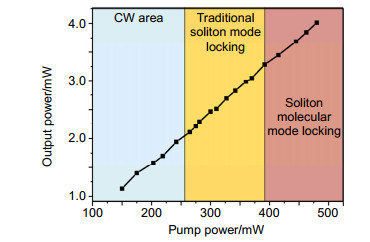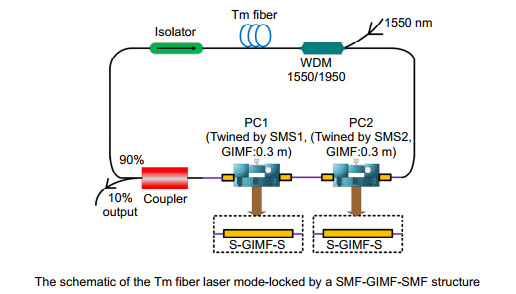-
摘要
本文报道了一种新兴的锁模方式-多模干涉锁模。这种锁模方式结构简单,搭建方便。在单模光纤激光器中熔接二段短的渐变折射率多模光纤,利用这种单模-多模-单模(SMS)结构的模式干涉效应实现可饱和吸收机制,从而实现锁模脉冲输出。SMS结构实现锁模需要对多模光纤的长度进行精确控制,本文提出将SMS结构缠绕进偏振控制器中,通过理论推导偏振控制器对多模光纤中传输光相位的调控,以实现可饱和吸收效应。在263 mW泵浦功率下实现了24.83 MHz重复频率的传统孤子脉冲输出,其脉冲间隔为40.12 ns,信噪比为50.8 dB,中心波长为1881.7 nm。通过调节偏振控制器和泵浦功率实现孤子分子与传统孤子脉冲的转换。在410 mW的泵浦阈值下实现了25 MHz重复频率的孤子分子脉冲输出,其脉冲间隔为40.3 ns,信噪比为54.4 dB,中心波长为1887.60 nm。
-
关键词:
- 光纤激光器 /
- 锁模激光器 /
- 单模-多模-单模光纤结构 /
- 非线性多模干涉
Abstract
We demonstrate a new mode-locking method: multimode interference mode-locking. This method is simple and convenient in construction. It is only necessary to fuse two short pieces of graded-index multimode fiber in a single-mode fiber laser, which uses the mode interference effect of single-mode multimode single-mode (SMS) structure to achieve saturable absorption mechanism. In order to realize the mode-locking of the SMS structure, it is necessary to precisely control the length of multimode fiber. We propose to coil the SMS structure into the polarization controller. By theoretically deriving the polarization controller to adjust the phase of transmission light in a multimode fiber, the saturable absorption effect can be achieved. Under the 263 mV pump power, a stable 24.83 MHz repetition frequency fundamental frequency mode-locked pulse output was realized, where the pulse interval was 40.12 ns, the signal-to-noise ratio was 50.8 dB, and the center wavelength was 1881.7 nm. The conversion between soliton molecules and traditional soliton can be realized by adjusting the polarization controller and pump power. Under the pump threshold of 410 mW, a stable 25 MHz repetition frequency soliton molecular mode-locked pulse output was realized, where the pulse interval was 40.3 ns, the signal-to-noise ratio was 54.4 dB, and the center wavelength was 1887.60 nm.
-
Overview
Overview: In recent years, the wide application of Thulium-doped fiber ultrafast mode-locked lasers in the wavelength band of about 2 μm due to its compact structure, narrow pulse width and high peak power has attracted great attention. It has important application prospects in material processing, gas detection, biomedicine, laser radar, etc. The ultrashort pulses in fiber lasers can be produced by using passive mode-locking technology produces. The key device that determines the mode-locking performance is the saturable absorber (SA). The SA with SMS structure has the advantages of simple structure, long-term stability, and high damage threshold. These advantages enable the laser to obtain higher pulse energy and peak power. In recent years, researchers have published many related studies on SMS as a SA. In 2013, Nazemosadat and Mafi theoretically proposed to use the SMF-GIMF-SMF (SMS) structure as the SA in the mode-locked fiber laser. In 2015, S. Fu demonstrated a Q-switched all-fiber laser using SMS as a SA. In 2017, Z. K. Wang et al. used stretched GIMF to obtain a stable pulse. In 2018, N. Wang reported the observation of SMS-based soliton, which introduced an internal microcavity in GIMF and used it as a nonlinear optical switch. In 2019, Zhang et al. improved the mode-locking properties of SMS by coiling it on the paddles of polarization controller (PC) in 1.5 μm band. It can be seen from the reports that it is difficult to achieve precise control of the length of SMS-based multimode fiber in practice.
In this paper, we report a method based on nonlinear multimode interference in the 2 μm band, using single-mode fiber-gradient index multimode fiber (GIMF)-single-mode fiber (SMS) which are twined into the PC as mode-locked fiber laser with saturable absorber, and the gain medium is the 2 m Thulium-doped fiber. In the SA structure, two SMSs are fused together, and each SMS is twined into the PC. By properly adjusting the PC's paddles, we can easily achieve mode locking. This structure reduces the control accuracy of GIMF length. Such an all-fiber SA is based on nonlinear multimode interference. Basically, stable mode-locking operation is obtained under the pump threshold of 410 mW. We have obtained a stable soliton molecule with a shortest pulse duration of 40.3 ns, a corresponding repetition frequency of 25 MHz, and a center wavelength of 1887.60 nm. The signal-to-noise ratio of RF spectrum is 54.4 dB. The conversion between soliton molecules and traditional soliton can be realized by adjusting the PC and input power. Using SMS as SA has many potential applications in human eye-safe ultrafast photonics.
-

-
-
参考文献
[1] Pal A, Sen R J, Bremer K, et al. "All-fiber" tunable laser in the 2 μm region, designed for CO2 detection[J]. Appl Opt, 2012, 51(29): 7011-7015. doi: 10.1364/AO.51.007011
[2] Hudson D D. Invited paper: short pulse generation in mid-IR fiber lasers[J]. Opt Fiber Technol, 2014, 20(6): 631-641. doi: 10.1016/j.yofte.2014.08.003
[3] Rudy C W, Digonnet M J F, Byer R L. Advances in 2-μm Tm-doped mode-locked fiber lasers[J]. Opt Fiber Technol, 2014, 20(6): 642-649. doi: 10.1016/j.yofte.2014.06.005
[4] Mingareev I, Weirauch F, Olowinsky A, et al. Welding of polymers using a 2 μm thulium fiber laser[J]. Opt Laser Technol, 2012, 44(7): 2095-2099. doi: 10.1016/j.optlastec.2012.03.020
[5] Nishizawa N, Nozaki Y, Itoga E, et al. Dispersion-managed, high-power, Er-doped ultrashort-pulse fiber laser using carbon-nanotube polyimide film[J]. Opt Express, 2011, 19(22): 21874-21879. doi: 10.1364/OE.19.021874
[6] Lan Y, Song Y J, Hu M L, et al. Enhanced spectral breathing for sub-25 fs pulse generation in a Yb-fiber laser[J]. Opt Lett, 2013, 38(8): 1292-1294. doi: 10.1364/OL.38.001292
[7] Wang Q, Geng J, Luo T, et al. Mode-locked 2 μm laser with highly thulium-doped silicate fiber[J]. Opt Lett, 2009, 34(23): 3616-3618. doi: 10.1364/OL.34.003616
[8] Wang Q, Geng J H, Jiang Z, et al. Mode-locked tm-ho-codoped fiber laser at 2.06μm[J]. IEEE Photonics Technol Lett, 2011, 23(11): 682-684. doi: 10.1109/LPT.2011.2123880
[9] Ma W Z, Zhao D S, Liu R M, et al. Observation and optimization of 2 μm mode-locked pulses in all-fiber net anomalous dispersion laser cavity[J]. Opto-Electron Adv, 2020, 3(11): 200001. doi: 10.29026/oea.2020.200001
[10] Kong L C, Xie G Q, Yuan P, et al. Passive Q-switching and Q-switched mode-locking operations of 2 μm Tm: CLNGG laser with MoS2 saturable absorber mirror[J]. Photonics Res, 2015, 3(2): A47-A50. doi: 10.1364/PRJ.3.000A47
[11] Zhang X J, Li W W, Li J, et al. Mid-infrared all-fiber gain-switched pulsed laser at 3 μm[J]. Opto-Electron Adv, 2020, 3(5): 190032. doi: 10.29026/oea.2020.190032
[12] Yan Z Y, Li X H, Tang Y L, et al. Tunable and switchable dual-wavelength Tm-doped mode-locked fiber laser by nonlinear polarization evolution[J]. Opt Express, 2015, 23(4): 4369-4376. doi: 10.1364/OE.23.004369
[13] Wang Q, Chen T, Zhang B, et al. All-fiber passively mode-locked thulium-doped fiber ring oscillator operated at solitary and noiselike modes[J]. Opt Lett, 2011, 36(19): 3750-3752. doi: 10.1364/OL.36.003750
[14] Jin X X, Wang X, Wang X L, et al. Tunable multiwavelength mode-locked Tm/Ho-doped fiber laser based on a nonlinear amplified loop mirror[J]. Appl Opt, 2015, 54(28): 8260-8264. doi: 10.1364/AO.54.008260
[15] Li J F, Zhang Z X, Sun Z Y, et al. All-fiber passively mode-locked Tm-doped NOLM-based oscillator operating at 2-μm in both soliton and noisy-pulse regimes[J]. Opt Express, 2014, 22(7): 7875-7882. doi: 10.1364/OE.22.007875
[16] Wang Z K, Wang D N, Yang F, et al. Stretched graded-index multimode optical fiber as a saturable absorber for erbium-doped fiber laser mode locking[J]. Opt Lett, 2018, 43(9): 2078-2081. doi: 10.1364/OL.43.002078
[17] Zhu X, Schülzgen A, Li H, et al. Single-transverse-mode output from a fiber laser based on multimode interference[J]. Opt Lett, 2008, 33(9): 908-910. doi: 10.1364/OL.33.000908
[18] Li H H, Wang Z K, Li C, et al. Mode-locked Tm fiber laser using SMF-SIMF-GIMF-SMF fiber structure as a saturable absorber[J]. Opt Express, 2017, 25(22): 26546-26553. doi: 10.1364/OE.25.026546
[19] Nazemosadat E, Mafi A. Nonlinear multimodal interference and saturable absorption using a short graded-index multimode optical fiber[J]. J Opt Soc Amer B, 2013, 30(5): 1357-1367. doi: 10.1364/JOSAB.30.001357
[20] Fu S J, Sheng Q, Zhu X S, et al. Passive Q-switching of an all-fiber laser induced by the Kerr effect of multimode interference[J]. Opt Express, 2015, 23(13): 17255-17262. doi: 10.1364/OE.23.017255
[21] Wang Z K, Wang D N, Yang F, et al. Er-doped mode-locked fiber laser with a hybrid structure of a step-index-graded-index multimode fiber as the saturable absorber[J]. J Lightwave Technol, 2017, 35(24): 5280-5285. doi: 10.1109/JLT.2017.2768663
[22] Yang F, Wang D N, Wang Z K, et al. Saturable absorber based on a single mode fiber-graded index fiber-single mode fiber structure with inner micro-cavity[J]. Opt Express, 2018, 26(2): 927-934. doi: 10.1364/OE.26.000927
[23] Zhang H W, Jin L, Zhang H, et al. All-fiber nonlinear optical switch based on polarization controller coiled SMF-GIMF-SMF for ultrashort pulse generation[J]. Opt Commun, 2019, 452: 7-11. doi: 10.1016/j.optcom.2019.07.004
[24] Uzma M, Zaheer M, Asif A, et al. Effect of phase shifting on self-imaging in optical multi-mode interference devices[C]//Proceedings of 2016 19th International Multi-Topic Conference, Islamabad, Pakistan, 2016: 1-5.
[25] Mehta A, Mohammed W, Johnson E G. Multimode interference-based fiber-optic displacement sensor[J]. IEEE Photonics Technol Lett, 2003, 15(8): 1129-1131. doi: 10.1109/LPT.2003.815338
[26] Wei L, Khattak A, Martz C, et al. Tunable multimode fiber based filter and its application in cost-effective interrogation of fiber-optic temperature sensors[J]. IEEE Photonics J, 2017, 9(2): 7101808.
[27] Khattak A, Tatel G, Wei L. Tunable and switchable erbium-doped fiber laser using a multimode-fiber based filter[J]. Appl Sci, 2018, 8(7): 1135. doi: 10.3390/app8071135
[28] Zhu X, Schülzgen A, Li H, et al. Detailed investigation of self-imaging in largecore multimode optical fibers for application in fiber lasers and amplifiers[J]. Opt Express, 2008, 16(21): 16632-16645. doi: 10.1364/OE.16.016632
[29] Daniault L, Hanna M, Lombard L, et al. Coherent beam combining of two femtosecond fiber chirped-pulse amplifiers[J]. Opt Lett, 2011, 36(5): 621-623. doi: 10.1364/OL.36.000621
-
访问统计


 E-mail Alert
E-mail Alert RSS
RSS

 下载:
下载:









